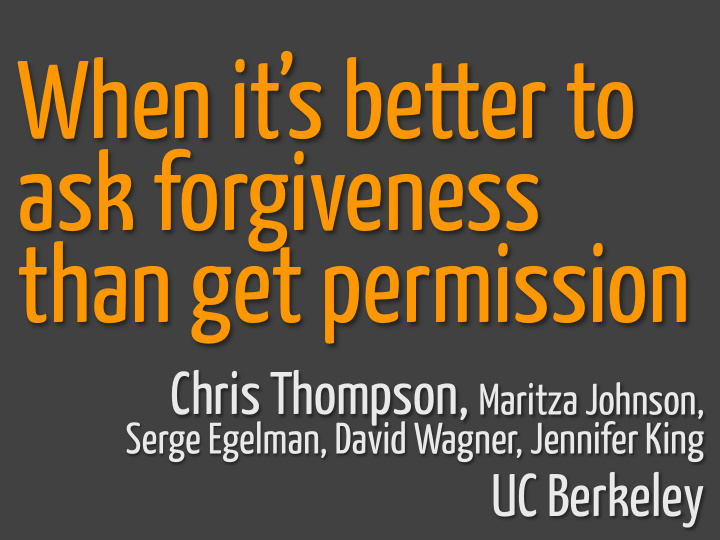



When it’s better to ask forgiveness than get permission Chris Thompson, Maritza Johnson, Serge Egelman, David Wagner, Jennifer King UC Berkeley
Designing attribution mechanisms for smartphone resources
Asking for permission:
“To avoid devaluing the warnings, we recommend that permissions without clear risks should not be shown to users. … Warnings that do not convey real risks teach the user that all warnings are unimportant.” A. P. Felt, E. Ha, S. Egelman, A. Haney, E. Chin, D. Wagner. Android Permissions: User Attention, Comprehension, and Behavior . Symposium On Usable Privacy and Security (SOUPS), 2012.
Existing mechanisms habituate the user.
Too many unnecessary user interactions All permission warnings more likely to be overlooked.
Low Risk & Reversible: 55% of permissions. (Felt et al., How to Ask For Permission , HotSec ‘12) Why not use mechanisms that don’t habituate the user?
Automatically grant permissions that are low risk and reversible …but allow the user to attribute behavior.
Attribution vs. Explicit Consent
Send texts, destroy data vs Turn on flash Change volume ¡ Vibrate
To limit habituation, when possible: Let apps use resources Help users fix misbehavior.
Are Attribution Mechanisms Effective? Online survey (n=189) to answer: – Are users aware of existing attribution mechanisms? – Do users know how to attribute misbehavior today?
73% of Android 4+ users found this. (95%CI: [58%, 85%])
What happens to apps in the background? I don't know Exits 11% 7% Fewer abilities 33% Same abilities 22% Suspends 28%
Users don’t understand background apps. Attribution mechanisms make explicit what app was responsible.
New attribution mechanisms
Provenance of Two settings changes Types Notifications of ongoing annoyances
Annotate with provenance of current wallpaper setting Desktop Chooser Display Settings
Annotate with provenance of current wallpaper setting Desktop Chooser Display Settings
Notification of ongoing behavior
Notification of ongoing behavior
Notification of ongoing behavior
Laboratory Experiment 76 Android users from Craigslist (68% male, ages 19-59) GROUP = EXPERIMENTAL NEW MECHANISMS = CONTROL STATUS GROUP QUO
Methodology Will participants identify the correct app that is causing an undesirable misbehavior? • When given attribution mechanisms? • When there are multiple apps running that all have the ability to cause the misbehavior?
Methodology Asked participants to evaluate several apps that we had installed on provided phones • Subterfuge to get several apps running in the background to create ambiguity • Modified Android to add new attribution mechanisms
① Play with and review timer apps.
① Play with and review timer apps. bzzzz bzzzz bzzzz bzzzz bzzzz bzzzz bzzzz bzzzz
② Explain vibration, repeat the misbehavior, and ask: “Which app just vibrated the phone?”
① Play with and review timer apps. ② Vibration triggered covertly. ¡ ③ Explain vibration, repeat vibration, and ask to attribute misbehavior. ¡
① Play with and review drawing apps. ② Bieber triggered covertly. ¡ ③ Explain Bieber, repeat Bieber, and ask to attribute Bieber. ¡
Once people noticed the misbehavior, did they blame the right app?
Experimental conditional significantly better for both resources 80.6% ¡ 34.3% ¡ with ¡no-fica-ons ¡ with ¡provenance ¡ 30.8% ¡ 7.9% ¡ without ¡no-fica-ons ¡ without ¡provenance ¡ Vibra-on ¡ Wallpaper ¡ (p<0.0005; Fisher’s exact test.) ¡ (p<0.006; Fisher’s exact test.) ¡ ¡
Correctness is correlated with confidence (Only in the experimental condition!) Vibration Wallpaper ρ = 0.526, p<0.0005 ρ = 0.663, p<0.0005 ¡ ¡
But did people notice?
48.7% (37 of 76) noticed vibration. Only 18% (13 of 74) noticed Bieber.
Users need to detect misbehaviors---otherwise they can’t use our attribution mechanisms. 30% correctly attributing misbehavior is good! Mechanisms aren’t perfect, but good enough to deter bad behaviors: • Users form opinions based on reviews and word-of-mouth ( Felt et al., SOUPS ‘12; Egelman, CHI ‘13 ) • Dissemination requires only a small number of savvy users • Increased confidence could yield more/better reviews
Make the user deal with fewer permission requests. When possible, automatically give apps permission . When an app needs forgiveness, help users fix problems .
It’s easier to ask forgiveness than it is to get permission . —Grace Hopper
CONTACT Chris Thompson http://www.cs.berkeley.edu/~cthompson cthompson@cs.berkeley.edu
Recommend
More recommend